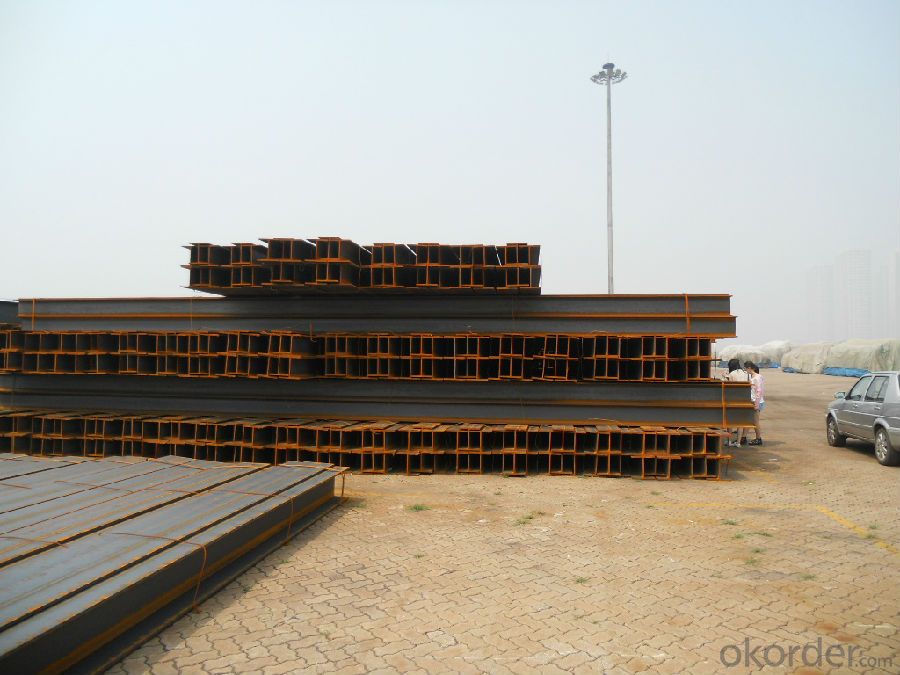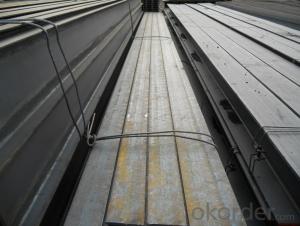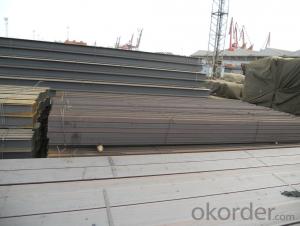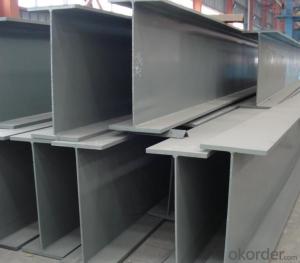Hot Rolled Steel JIS H Beam Small Size
- Loading Port:
- China Main Port
- Payment Terms:
- TT or LC
- Min Order Qty:
- -
- Supply Capability:
- -
OKorder Service Pledge
OKorder Financial Service
You Might Also Like
Product Description:
OKorder is offering high quality Hot Rolled Steel I-Beams at great prices with worldwide shipping. Our supplier is a world-class manufacturer of steel, with our products utilized the world over. OKorder annually supplies products to European, North American and Asian markets. We provide quotations within 24 hours of receiving an inquiry and guarantee competitive prices.
Product Applications:
Hot Rolled Steel I-Beams are ideal for structural applications and are widely used in the construction of buildings and bridges, and the manufacturing, petrochemical, and transportation industries.
Product Advantages:
OKorder's Steel I-Beams are durable, strong, and resist corrosion.
Main Product Features:
· Premium quality
· Prompt delivery & seaworthy packing (30 days after receiving deposit)
· Corrosion resistance
· Can be recycled and reused
· Mill test certification
· Professional Service
· Competitive pricing
Product Specifications:
Manufacture: Hot rolled
Grade: Q195 – 235
Certificates: ISO, SGS, BV, CIQ
Length: 6m – 12m, as per customer request
Packaging: Export packing, nude packing, bundled
SIZE(mm) | DIMENSION(kg/m) |
100*100 | 16.9 |
125*125 | 23.6 |
150*75 | 14 |
150*150 | 31.1 |
148*100 | 20.7 |
198*99 | 17.8 |
200*100 | 20.9 |
248*124 | 25.1 |
250*125 | 29 |
Packaging & Delivery of Hot Rolled Structural Steel H Beam
1. Packing: it is nude packed in bundles by steel wire rod
2. Bundle weight: not more than 3.5MT for bulk vessel; less than 3 MT for container load
3. Marks:
Color marking: There will be color marking on both end of the bundle for the cargo delivered by bulk vessel. That makes it easily to distinguish at the destination port.
Tag mark: there will be tag mark tied up on the bundles. The information usually including supplier logo and name, product name, made in China, shipping marks and other information request by the customer.
If loading by container the marking is not needed, but we will prepare it as customer request.
4. Transportation: the goods are delivered by truck from mill to loading port, the maximum quantity can be loaded is around 40MTs by each truck. If the order quantity cannot reach the full truck loaded, the transportation cost per ton will be little higher than full load.
5. Delivered by container or bulk vessel
FAQ:
Q1: How soon can we receive the product after purchase?
A1: Within three days of placing an order, we will begin production. The specific shipping date is dependent upon international and government factors, but is typically 7 to 10 workdays.
Q2: What makes stainless steel stainless?
A2: Stainless steel must contain at least 10.5 % chromium. It is this element that reacts with the oxygen in the air to form a complex chrome-oxide surface layer that is invisible but strong enough to prevent further oxygen from "staining" (rusting) the surface. Higher levels of chromium and the addition of other alloying elements such as nickel and molybdenum enhance this surface layer and improve the corrosion resistance of the stainless material.
Q3: Can stainless steel rust?
A3: Stainless does not "rust" as you think of regular steel rusting with a red oxide on the surface that flakes off. If you see red rust it is probably due to some iron particles that have contaminated the surface of the stainless steel and it is these iron particles that are rusting. Look at the source of the rusting and see if you can remove it from the surface.
Images:


- Q:What are the typical uses of steel H-beams in construction projects?
- Steel H-beams are commonly used in construction projects for a variety of purposes. They are primarily used as structural support members in buildings and bridges, providing strength and stability. H-beams are often used to create the framework for large structures, such as high-rise buildings and industrial facilities. They are also utilized in the construction of bridges, where their load-bearing capacity is crucial. Additionally, H-beams can be used as columns or beams to support heavy loads and provide structural integrity. Overall, the typical uses of steel H-beams in construction projects include providing structural support, creating frameworks, and ensuring the stability and strength of various structures.
- Q:Can steel H-beams be used for utility poles?
- Using steel H-beams for utility poles is not advisable. Utility poles are typically constructed using wood or concrete due to their specific properties that make them more suitable for this purpose. Wood is a lightweight material that is easy to handle and provides effective insulation against electricity. On the other hand, concrete poles are highly durable, resistant to various weather conditions, and have a longer lifespan compared to wood poles. Steel H-beams, however, are primarily utilized in construction for structural support in buildings and bridges. Although they possess great strength and can withstand heavy loads, they are not designed to meet the specific requirements of utility poles, such as electrical insulation and resistance to rot and decay. Therefore, it is not recommended to employ steel H-beams for utility poles.
- Q:Are steel H-beams susceptible to bending or warping?
- Under normal circumstances, Steel H-beams are generally resistant to bending or warping. These beams are specifically engineered to be structurally strong and are widely utilized in construction and engineering projects that necessitate load-bearing capacity. The H-shape of these beams provides exceptional resistance against bending forces. Nevertheless, it is imperative to acknowledge that extreme external forces or mishandling during transportation or installation have the potential to induce bending or warping. Moreover, if the H-beams are not designed or manufactured in accordance with the required standards, they may be more prone to bending or warping. To guarantee the structural soundness of steel H-beams, it is vital to adhere to proper installation procedures, handle them with caution, and utilize beams that meet industry standards and specifications. Regular maintenance and inspections are also crucial to promptly identify any indications of bending or warping and address them promptly.
- Q:Can steel H-beams be used for modular construction?
- Yes, steel H-beams can be used for modular construction. Steel H-beams are commonly used in the construction industry due to their strength, durability, and versatility. They can be easily fabricated and assembled into various modular structures, making them suitable for modular construction projects. The H shape of the beams provides excellent load-bearing capabilities, allowing for the construction of large and stable modular units. Additionally, steel H-beams are resistant to fire, pests, and weather conditions, making them a reliable choice for modular construction projects in a variety of environments.
- Q:What are the common surface treatments available for steel H-beams?
- There are several common surface treatments available for steel H-beams, which are used to enhance their durability, appearance, and resistance to corrosion. These treatments include: 1. Hot-dip galvanizing: This process involves immersing the steel H-beams in a bath of molten zinc, forming a protective coating on the surface. Galvanizing provides excellent corrosion resistance and is commonly used in outdoor or high-moisture environments. 2. Powder coating: Powder coating involves applying a dry powder to the surface of the steel H-beams, which is then heated and fused onto the metal. This process creates a durable and attractive finish that is resistant to chipping, scratching, and fading. 3. Epoxy coating: Epoxy coatings provide a protective layer over the steel H-beams, offering resistance to corrosion, chemicals, and abrasion. This treatment is often used in industrial settings where the beams may come into contact with harsh substances. 4. Painting: Painting is a common surface treatment for steel H-beams, providing both aesthetic appeal and protection against corrosion. The beams are typically primed and then coated with a high-quality paint that is resistant to weathering and UV rays. 5. Shot blasting: Shot blasting involves propelling small metallic or abrasive particles at high speeds onto the surface of the steel H-beams. This process removes rust, mill scale, and other impurities, leaving a clean and roughened surface that is ready for further treatment. These surface treatments can be chosen based on the specific requirements of the steel H-beams, such as the intended application, environmental conditions, and aesthetic preferences. It is essential to consider factors like cost, durability, maintenance, and the expected lifespan of the beams when selecting the most suitable surface treatment.
- Q:What are the considerations when designing for thermal bridging in Steel H-Beams?
- When it comes to designing for thermal bridging in steel H-beams, several factors must be taken into account. To begin with, it is crucial to recognize that steel is a highly conductive material, meaning it conducts heat more effectively than other building materials like wood or insulation. As a result, steel H-beams are susceptible to thermal bridging, which involves the transfer of heat across a solid structure, leading to heat loss or gain. To address thermal bridging in steel H-beams, one consideration is the incorporation of a thermal break. This entails adding a layer of insulation between the steel beam and the surrounding components. The insulation acts as a barrier, preventing the transfer of heat and reducing thermal bridging. Various materials, such as rigid foam insulation or specially designed insulating materials, can be used for thermal breaks. Another aspect to consider is the overall design of the building envelope. By optimizing insulation levels and minimizing the presence of steel H-beams in areas of high thermal importance, it is possible to reduce the potential for thermal bridging. Additionally, proper placement and sizing of insulation around the beams can help minimize heat transfer. Furthermore, detailed and careful construction practices are essential when designing for thermal bridging in steel H-beams. It is crucial to ensure that the insulation is installed correctly and fully covers the steel beams, leaving no gaps or voids that could compromise thermal performance. Proper sealing and weatherproofing of the building envelope are also vital to prevent air leakage, which can worsen thermal bridging. Lastly, the long-term durability and maintenance of the thermal solution should be taken into consideration. The chosen insulation materials should be durable, moisture-resistant, and able to withstand the potential stresses and movements of the steel beams. Regular inspections and maintenance should be conducted to ensure that the insulation remains intact and in good condition. Overall, by considering the thermal properties of steel H-beams and implementing suitable design strategies, it is possible to minimize thermal bridging and enhance the energy efficiency of a building.
- Q:Can Steel H-Beams be used in roof or ceiling construction?
- Yes, Steel H-Beams can be used in roof or ceiling construction. Steel H-Beams are commonly used in structural applications, including roof and ceiling construction, due to their strength and durability. They provide excellent support and load-bearing capacity, making them ideal for spanning large distances and supporting heavy loads. Additionally, steel H-Beams offer flexibility in design and allow for greater open spaces without the need for excessive columns or supports. Overall, steel H-Beams are a popular choice in roof and ceiling construction due to their structural properties and versatility.
- Q:What are the dimensions of a standard steel H-beam?
- The dimensions of a standard steel H-beam can vary depending on the specific design and manufacturer. However, there are commonly used dimensions for standard steel H-beams. These beams typically have a width or flange that ranges from 100 millimeters to 900 millimeters, a height or web that ranges from 100 millimeters to 300 millimeters, and a thickness or weight per meter that ranges from 17 kilograms to 166 kilograms. It is important to note that these dimensions can be subject to variations and specific requirements based on the intended use and load-bearing capacity of the H-beam.
- Q:Are steel H-beams suitable for buildings with heavy machinery or equipment?
- Yes, steel H-beams are highly suitable for buildings with heavy machinery or equipment. H-beams are designed to provide exceptional strength and durability, making them ideal for supporting heavy loads. The shape of the H-beam, with its flanges and web, offers excellent structural integrity and allows for superior weight distribution. Additionally, steel is known for its high tensile strength and resistance to deformation, making it a reliable choice for heavy-duty applications. Therefore, steel H-beams provide a solid foundation for buildings that need to accommodate heavy machinery or equipment, ensuring the structural stability and safety of the overall construction.
- Q:How do steel H-beams compare to aluminum beams in terms of strength and weight?
- Steel H-beams are typically stronger than aluminum beams in terms of both strength and weight. Steel is a much denser material than aluminum, meaning that steel beams can withstand higher loads and have a higher tensile strength compared to aluminum beams of the same size. This makes steel H-beams the preferred choice in structural applications that require high strength and durability. Although aluminum beams are lighter in weight compared to steel beams, they are generally not as strong. However, the lower weight of aluminum beams can be advantageous in certain applications where weight reduction is a priority, such as in the aerospace industry or for portable structures. Aluminum beams are also more resistant to corrosion, which makes them suitable for environments with high moisture or salt exposure. In summary, steel H-beams are stronger than aluminum beams, but aluminum beams are lighter and more corrosion-resistant. The choice between the two materials depends on the specific requirements of the project, including the desired strength, weight, and environmental factors.
1. Manufacturer Overview |
|
|---|---|
| Location | |
| Year Established | |
| Annual Output Value | |
| Main Markets | |
| Company Certifications | |
2. Manufacturer Certificates |
|
|---|---|
| a) Certification Name | |
| Range | |
| Reference | |
| Validity Period | |
3. Manufacturer Capability |
|
|---|---|
| a)Trade Capacity | |
| Nearest Port | |
| Export Percentage | |
| No.of Employees in Trade Department | |
| Language Spoken: | |
| b)Factory Information | |
| Factory Size: | |
| No. of Production Lines | |
| Contract Manufacturing | |
| Product Price Range | |
Send your message to us
Hot Rolled Steel JIS H Beam Small Size
- Loading Port:
- China Main Port
- Payment Terms:
- TT or LC
- Min Order Qty:
- -
- Supply Capability:
- -
OKorder Service Pledge
OKorder Financial Service
Similar products
New products
Hot products
Related keywords




























